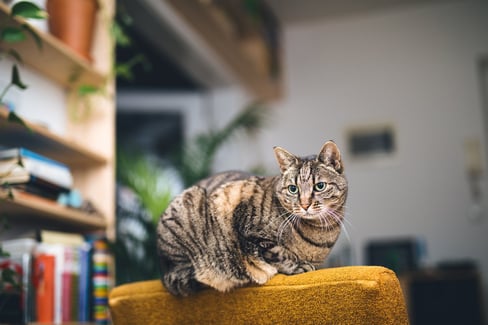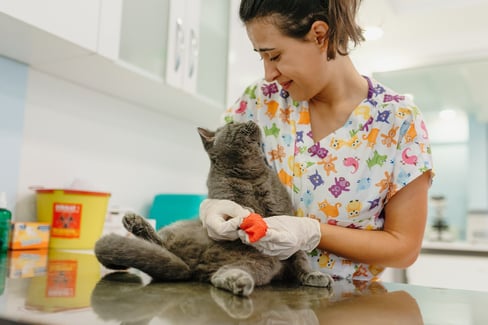Table of Contents
Cats love to scratch. Scratching helps them relieve stress, stretch their muscles, and work their joints. Cats also use scratching to express emotions, like excitement. Does your cat run over to their scratching post every time you grab a can of their favourite wet food? That’s because they are so excited to eat that their brain is telling them to express that excitement through a good scratch.
Scratching is also a way for cats to mark objects with their scent. The scent glands in their paw pads leave a distinct smell that indicates that your cat was there. This gives a signal to other pets in your house, but even if your cat is the only pet in your house, you’re still likely to find them scratching different surfaces to leave their scent. This is similar to how a cat will rub their cheeks and corners of their mouth on different objects. A cat leaving their scent on an object is one way that they communicate “This is mine”.
But as much as we love our cats and understand why they scratch, we don’t love it when they tear the corner of our brand-new couch to pieces or leave claw marks on the baseboards. We also don’t appreciate it when they scratch us!
To prevent damage caused by cat scratching, some owners have opted to declaw their cats. Declawing cats, which is called onychectomy, is exactly what it sounds like. The claws on the front and/or back feet are completely removed, eliminating the possibility of the cat scratching furniture or people and causing damage or injury.
While this procedure was once quite common, the practice is now generally frowned upon and has been banned in some areas.
In this article, we explore more about declawing cats, including why it was, and in some cases still is done, what the procedure entails, and alternatives to declawing cats.
Why Was Declawing Cats Previously Common?
There are many reasons why people want to declaw cats. To save their furniture. To prevent the cat from scratching them or their children. But the common reason underlying all of these is convenience. It’s much easier to simply declaw a cat rather than try different methods that might not work or only work temporarily, like trying to redirect the behaviour with a toy or using a product like an anti-scratching spray.
There are a ton of misconceptions surrounding declawing cats that have been perpetuated by years of the procedure being a common offering at veterinarian offices, especially in North America. These misconceptions include:
- Declawing cats doesn’t hurt them. The fact is, declawing a cat is extremely painful for your feline friend. We’ll get into more detail about the procedure itself in later sections of this article, but imagine that you had to undergo a procedure where you got your fingers cut off just below your first knuckle. Think about how losing the majority of your fingers would affect your life and the lasting pain that you would likely experience in what remains of your hand. This is what a cat experiences when they get a declaw procedure.
- Declawing is just removing the nails from a cat’s paw. Declawing a cat is similar to an amputation. A typical declaw procedure involves cutting through tendons, ligaments, and nerves to remove each claw.
- Declawing a cats' front claws only is not as bad as getting all claws removed. While this might have some truth to it, it’s more like a lesser of two evils. Sure, it’s better to declaw cats' front paws only compared to declawing their back feet as well, but it’s like saying that if someone cuts off one of your hands, there shouldn’t be as harsh of a punishment as if they cut off both of your hands. The best is not declawing the cat at all.
- Declawing indoor cats is okay as long as they are not let outside because then they can’t defend themselves. This is another misconception that is trying to use mental gymnastics to say that declawing cats isn’t bad if you protect them from predators or fighting. But cats don’t just use their claws for self-defence; scratching helps them stretch, remove dead and loose nails, and makes them feel good.
The procedure was once fairly common because cat owners and some veterinarians didn’t believe that declawing cats was harmful to the animal’s health. Even though declawing cats is a surgery that’s not done for any medical reason, for years it was a relatively standard procedure around the world, particularly in North America. A survey of routine elective procedures conducted in 1988 and 1996 shows that it was performed alongside neutering in more than 20% of cases.
Interestingly, the attitudes surrounding declawing cats were much more progressive across the pond in Europe and the UK. Many European countries signed a treaty to ban the practice in the early 1990s, while declawing cats in the UK was apparently always a rare procedure before it was completely outlawed in 2006. In fact, part of the reason they ended up taking place was because more and more Americans brought their cats to the UK, which highlighted the prevalence of issues with cats that are declawed.
Declawing Cats for Medical Reasons
The truth is, that declawing a cat is never medically necessary or recommended. It is a completely elective procedure that is done only because the cat owner wants it to be done. There may be some rare cases where a cat’s toe or claw does need to be removed because it has been damaged due to trauma, but that procedure is usually referred to as an amputation (and rightly so) rather than a “cat declaw”.
Understanding The Procedure of Declawing Cats
We’re going to get a little graphic for a moment, but it’s for a good reason. Declawing cats involves physically cutting off (amputating) the last bone of each toe, called the third phalanx. This is why the comparison of cutting off your fingers at the first knuckle is made because it’s the most similar structure on the human body to a cat’s claw.
The amputation occurs using either the guillotine, scalpel, or laser method, which are described in more detail in the following table:
|
Method for Declawing a Cat |
Description |
|
Guillotine |
Uses a guillotine nail trimmer to cut off the third phalanx of each toe. Due to the lack of precision with this method, the surrounding structures of the toe are likely to be damaged (skin, tissue, muscle, nerves, etc.) leading to chronic pain for your cat. This method can also leave fragments of the third phalanx behind, contributing to pain and discomfort. |
|
Scalpel |
Involves cutting the third phalanx using a scalpel. While this method is more accurate compared to the guillotine, it requires more anesthetic and the use of a tourniquet to limit bleeding. The use of a tourniquet can compress the nerves in the paws and cause temporary paralysis as a result. |
|
Laser |
Involves using a laser to cut off the phalanx, which ligates the blood vessels and burns the nerve endings of the toe. This not only can cause burns which then need to be treated, but often results in fragments being left behind, which results in chronic pain. |
The laser method of declawing cats is thought to be the “best” method, as it results in less bleeding and a reduced chance of infection. It’s also always permanent, whereas with the other procedures, there’s always a chance that claws may grow back. However, like all declawing procedures, laser declawing will still result in pain and discomfort for your kitty.
What You Need to Know About Declawing Adult Cats vs Kittens
Some may think that it’s better to declaw a cat when they are a kitten rather than an adult because they will be better able to adapt to the results of the procedure. One of these results will be that they will need to walk further back on their feet. Cats walk on the balls of their feet and use their toes, so a kitten that’s missing the front part of their toes will need to learn how to walk differently. In addition, in kittens, the bones in the toes that are part of the removal will not be fully developed, making it easier to perform the procedure.
Declawing adult cats is a bit different. Adult cats have a higher chance of being unable to walk, run, and jump properly without having pain if they are declawed. This is because the bones in their toes are fully formed, so the procedure for removing them is more involved. It’s also important to remember that adult cats are more used to having their claws and toes and using them to walk, so adapting to not having them is more difficult.
In essence, declawing cats at any age isn’t recommended, but the older the cat is, the more you can expect negative side effects from the procedure that range the full gambit from physical to behavioural.
Why You Should Stop Declawing Cats
To fully appreciate why we should stop declawing cats, we must understand more about how a cat is built. A cat’s body weight is distributed across all 18 of their toes, and walks using the ball of their foot and their toes for balance. In other words, a cat walks on their toes in addition to their little paw pads. Therefore, the main issues with declawing cats stem from the sudden realization that they can’t walk on their toes anymore and can’t use those toes for regular behaviours that they are used to doing, like scratching.
Overall, declawing cats often results in chronic pain, permanent behavioural problems, and a host of other negatives that outweigh any convenience-related benefits that cat owners gain.
Adverse Side Effects from Declawing Cats
The negative effects that often result from declawing your cats include:
1. Fragments of Claws Left Behind
The prevalence of structures left behind from a declaw procedure is quite high. Most veterinarians who still offer the procedure will warn cat owners about this because complete removal of the third phalanx is quite difficult to do. In one study that analyzed 137 declawed cats, 86 of them (63%) showed radiographic evidence of residual third phalanx fragments. This is problematic not only because the resulting fragments can cause pain but also because these fragments can grow and develop and cause further issues down the road.
2. Litter Box Issues
A common behaviour of declawed cats is no longer wanting to use their litter box. This is often due to the fact that their paws are sensitive and painful from the surgery, but the behaviour can continue even after they are healed. Cats instinctively want to bury their waste, but if the pain and discomfort in their paws prevents them from doing so, they may associate those feelings with the litter box itself and refuse to use it. The refusal to use the litter box because of pain association is also common in cats that have urinary tract infections.
3. Trouble Walking, Running, Jumping, and Climbing
Cats are natural acrobats, always wanting to get to the highest place to observe their kingdom (even if it’s just the living room or kitchen). But when the key part of their foot is removed, as you can imagine it’s much more difficult (if not impossible) for them to perform these actions, especially pain-free. Declawed cats are more likely to develop movement-related problems, including issues walking, limping, and overall lameness.
4. Surgical Complications
Surgical complications from declawing cats are common, occurring in up to 50% of all declaw procedures. These potential surgical complications include:
- Hemorrhage: One of the most commonly reported complications with declawing cats, especially with older cats. In one study, hemorrhage was observed in 51 of 163 cats (31%) for one to 13 days after surgery, and more often in older cats.
- Claw regrowth: This condition happens because of incomplete removal of the claw, and can result in abscess formation and pain. According to the American Veterinary Association at the link above, approximately 3% of declawed cats show claw regrowth, but a 10% instance was reported when using a technique that left the flexor surface of the third phalanx in place.
- Wound dehiscence: In one case at a veterinary teaching hospital, 17% of cats at that hospital who were declawed suffered from wound dehiscence (partial or total separation of partially healed wound edges). Although this condition is rare, it can result in lameness.
5. Biting and Aggression
Scratching is a normal behaviour for cats, so when we take away the ability to perform that behaviour, it causes stress. Although between 59 and 78% of declawed cats will continue to try to scratch even without their claws, many will increase biting and other aggressive behaviours like biting and hissing. Although there are conflicting studies on the issue (where some studies say that these behaviours don’t increase with declawing) there is plenty of anecdotal evidence from cat owners that suggest it is perhaps a more prevalent issue than what has been reported.
Declawing Cats is Illegal in Some Areas
Declawing isn’t only frowned upon in some areas, it’s considered an illegal procedure for a veterinarian to perform. Many parts of Europe may have banned declawing in the 1990s, but the practice has only recently been banned in many parts of Canada and the United States.
The table below outlines the areas in these two countries where declawing cats is now illegal:
|
Areas In Canada Where Declawing Your Cats Is Illegal |
Areas In The United States Where Declawing Your Cats Is Illegal |
|
|
* Locations as of January 2024
Alternatives To Declawing Cats
Just because declawing cats isn’t recommended doesn’t mean that you have to live with your kitty scratching your furniture. There are a wide variety of alternatives available to declawing that are proven to work. These alternatives include:
1. Scratching Posts / Surfaces
Every kitty needs a great scratching post. These essential kitty furniture pieces are usually vertical wooden logs covered with carpet or thick twine so that your kitty can really dig their claws into it. Sometimes scratching posts can also have open or covered platforms that your kitty can sleep or play on. Most cats will instinctively go to a scratching post to scratch it because it has an alluring material that seems like it would be great for a good scratch. Other times, cat owners may need to sprinkle a bit of catnip on the post or lure their kitties over to it with a few treats.
Be sure to place the cat scratching post near their typical sleeping area or litter tray, as these areas are places your kitty will visit frequently. It’s also a good idea to place a scratching post in front of or near an object that they like to scratch, but don’t want them to. Placing a scratching post beside the arm of your couch, for example, helps give your kitty an alternative thing to scratch besides the side of your couch.
Other scratching surfaces, like cardboard scratchers or scratch mats, are useful to have around the house to give your cat different textures and surfaces to scratch aside from their scratching post.
2. Scratching Aversions
There are also a variety of cat scratching aversions that you can use to deter your kitty from scratching a particular surface. These include products such as:
- Double-sided sticky tape or “sticky paws”—placing double-sided sticky tape directly on the area is an easy way to deter your cat from scratching since cats hate the feeling of stickiness on their paws. Just be sure to use a wide form of tape to cover as much of the surface as possible.
- Furniture scratch guards—these are essentially plastic protectors that stick or are pinned to your couch to protect the surface from being damaged from your cat scratching it. These aren’t deterrents, but the hard plastic will protect your couch from damage.
- Anti-scratch spray—these products are sold in most pet stores and are a spray that you apply directly to a surface that has a smell that most cats hate, therefore deterring them from scratching. However, reviews are mixed as to whether these products actually work or not—some cat owners swear by them, while others state that they don’t work for their cats at all.
3. Nail Trimming
One of the best ways to control your cat’s scratching is by trimming their claws regularly. Getting a kitten used to nail trimming is key to ensure cooperation for the procedure later in life, but worst case scenario most veterinary clinics offer the service for a nominal fee.
Declawing cats vs trimming their nails are two procedures that can’t really be compared. Declawing involves complete amputation of your cat’s claw and toe bones, while nail trimming is simply cutting the claw down to a manageable length, just like humans cut their nails.
There are three main parts of a cat’s nail:
- The claw (white or yellowish semi-transparent part)
- The quick (area where the nerves and blood vessels in the nail are located)
- The sheath (the structure that holds the nail to the bone)
With nail trimming, pet owners have to be careful to not cut too much off—accidentally cutting the quick can result in some pain for your kitty. As a general rule of thumb, it’s better to cut less of the nail than more to avoid accidentally cutting the quick.
4. Soft Claws / Nail Caps
A recent product that has gained popularity among cat owners are soft claws or nail caps for cats. These are soft vinyl caps that are glued directly to each of your cat’s claws, similar to how people would apply fake nails. Because the covers are soft, they don’t cause damage when your cat scratches a surface.
Most cat owners find that they need a helper to apply them, but once they are on your cat, they can last for six weeks or more. Your cat will still be able to retract their claws and walk normally with the caps on their claws. It may take some time for your cat to get used to these tiny caps, but once your cat does get used to them, these caps can be an extremely useful tool to prevent damage from scratching.
Summary
The practice of declawing cats has long been a contentious issue, rooted in the desire to protect furniture or prevent injury, but it comes at a severe cost to feline companions. Understanding the true nature of declawing—essentially an amputation—sheds light on the immense pain and lasting effects it inflicts upon cats. While once a common procedure, its true ramifications, including chronic pain, behavioural issues, and long-term health problems, have led to its ban in many places worldwide.
Recognizing the adverse effects on cats—such as litter box aversion, mobility issues, and behavioural changes—underscores the importance of exploring alternatives. Scratching posts, aversions, regular nail trimming, and innovative solutions like nail caps offer effective ways to protect furniture without subjecting cats to unnecessary pain and suffering.
Speaking of nails, protecting your cat’s joints is another essential part of their health. Many cats suffer joint issues, especially when they reach their senior years. Incorporating a cat supplement for your cat’s joints into their diet helps them continue to move comfortably as they age.
Purchase TRI-ACTA online or learn where to buy at a store near you.
TRI-ACTA H.A. for Pets
Our maximum strength formula is optimally designed to accelerate the formation of cartilage, minimize inflammation, expedite the healing process, and improve joint conditions.

Newsletter Signup
Subscribe to our newsletter to receive the latest news and exclusive offers.
.jpg?height=2000&name=Cliick_Integricare-DISPLAY-REVISEDV2%20(1).jpg)
Proactive & Therapeutic Joint Supplements
When given daily, Integricare joint supplements recover bone and joint injuries faster and help prevent mobility injuries from happening in the first place.











